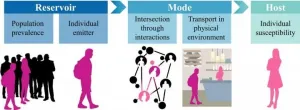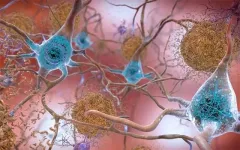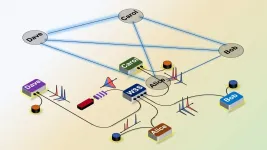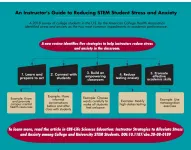Cooperative eco-driving automation improves energy efficiency and safety
2021-03-02
(Press-News.org) Imagine you're driving up a hill toward a traffic light. The light is still green so you're tempted to accelerate to make it through the intersection before the light changes. Then, a device in your car receives a signal from the controller mounted on the intersection alerting you that the light will change in two seconds -- clearly not enough time to beat the light. You take your foot off the gas pedal and decelerate, saving on fuel. You feel safer, too, knowing you didn't run a red light and potentially cause a collision in the intersection.
Connected and automated vehicles, which can interact vehicle to vehicle (V2V) and between vehicles and roadway infrastructure like traffic signals and stop signs (V2I), promise to save energy and improve safety. In a new study published in Transportation Research Part B, engineers from Michigan Technological University propose a modeling framework for V2V and V2I cooperative driving.
Cooperative driving helps cars and their drivers safely and efficiently navigate. The framework uses an eco-driving algorithm that prioritizes saving fuel and reducing emissions. The automated algorithm calculates location-based traffic control devices and roadway constraints using maps and geographic information. The research is led by Kuilin Zhang, associate professor of civil and environmental engineering and affiliated associate professor of computer science at Michigan Tech, along with Shuaidong Zhao '18, now a senior quantitative analyst at National Grid.
For the past three years, Houghton, Michigan, has been home to roadside units installed on five of the city's traffic signals that make V2I communication possible. Zhang conducted a simulation analysis using real traffic signal phasing and timing messages from the Ann Arbor connected vehicle test environment and plans to expand testing in the Houghton area.
"The whole idea of cooperative driving automation is that the signals in the intersection tell your car what's happening ahead," Zhang said. "The sensor at the intersection can benefit all connected vehicles passing through the intersection. The automated eco-driving algorithm improves the driving decisions of the connected and automated vehicles."
The simulation results show that the cooperative automated eco-driving algorithm saves energy -- 7% under light traffic and 23% under heavy traffic along the corridor.
"The stop and go, stop and go, it may use a lot of energy," Zhang said. "The concept of eco-driving incorporates how the vehicle makes driving decisions using data not only from vehicles in front of it, but also with information given from a traffic signal."
Zhang's model pulls in high-definition (HD) maps, which use a connected vehicle's hardware and software to provide down-to-the-centimeter accuracy in navigation. HD maps incorporate multiple types of environmental sensing: long-range radar, lidar, camera footage, short/medium-range radar and ultrasound.
Zhang said for autonomous driving, it's important to know landmarks to control the car's driving, as well as hill grades; using a hill to slow or accelerate a car can also increase energy savings. It's easy to conserve energy on a straight highway; on busy arterial streets with traffic and stoplights, energy conservation isn't so simple. On city streets, Zhang and Zhao's online predictive connected and automated eco-driving model considers traffic control devices and road geometry constraints under light and heavy traffic conditions.
INFORMATION:
[Attachments] See images for this press release:

ELSE PRESS RELEASES FROM THIS DATE:
2021-03-02
Type 2 diabetes, once considered an adult disease, is increasingly causing health complications among American youth. A research review published in the Journal of Osteopathic Medicine suggests physicians should work to more aggressively prevent pediatric diabetes.
Because few pediatric Type 2 diabetes treatment options are available, prevention is unusually important. To improve health outcomes, the paper's authors recommend physicians conduct regular screenings of children and adolescents, adopt a high level of suspicion, and intervene early and often with families who have children at risk for prediabetes and T2 diabetes.
"Pediatric type 2 diabetes is more progressive and aggressive than adult-onset Type 2 diabetes," ...
2021-03-02
Boulder, Colo., USA: Several articles were published online ahead of print
for GSA Bulletin in February. Topics include earthquake cycles in
southern Cascadia, fault dynamics in the Gulf of Mexico, debris flow after
wildfires, the assembly of Rodinia, and the case for no ring fracture in
Mono basin.
Jurassic evolution of the Qaidam Basin in western China: Constrained by
stratigraphic
succession, detrital zircon U-Pb geochronology and Hf isotope analysis
Tao Qian; Zongxiu Wang; Yu Wang; Shaofeng Liu; Wanli Gao ...
Abstract:
The formation and evolution of an intracontinental basin triggered via the
subduction or collision of plates at continental margins can record
intracontinental tectonic processes. As a typical ...
2021-03-02
In the 1995 movie "Outbreak," Dustin Hoffman's character realizes, with appropriately dramatic horror, that an infectious virus is "airborne" because it's found to be spreading through hospital vents.
The issue of whether our real-life pandemic virus, SARS-CoV-2, is "airborne" is predictably more complex. The current body of evidence suggests that COVID-19 primarily spreads through respiratory droplets - the small, liquid particles you sneeze or cough, that travel some distance, and fall to the floor. But consensus is mounting that, under the right circumstances, smaller floating particles called aerosols can carry the virus over longer distances and remain ...
2021-03-02
Amyloid plaques are pathological hallmarks of Alzheimer's disease (AD) -- clumps of misfolded proteins that accumulate in the brain, disrupting and killing neurons and resulting in the progressive cognitive impairment that is characteristic of the widespread neurological disorder.
In a new study, published March 2, 2021 in the Journal of Experimental Medicine (JEM), researchers at University of California San Diego School of Medicine, Massachusetts General Hospital and elsewhere have identified a new drug that could prevent AD by modulating, rather than inhibiting, a key enzyme involved ...
2021-03-02
WEST LAFAYETTE, Ind. -- When quantum computers become more powerful and widespread, they will need a robust quantum internet to communicate.
Purdue University engineers have addressed an issue barring the development of quantum networks that are big enough to reliably support more than a handful of users.
The method, demonstrated in a paper published in Optica, could help lay the groundwork for when a large number of quantum computers, quantum sensors and other quantum technology are ready to go online and communicate with each other.
The team deployed a programmable switch to adjust how much data goes to each ...
2021-03-02
Scientists regularly use remote sensing drones and satellites to record how climate change affects permafrost thaw rates -- methods that work well in barren tundra landscapes where there's nothing to obstruct the view.
But in boreal regions, which harbor a significant portion of the world's permafrost, obscuring vegetation can stymy even the most advanced remote sensing technology.
In a study published in January, researchers in Germany and at the University of Alaska Fairbanks' Geophysical Institute developed a method of using satellite imagery to measure the depth of thaw directly above permafrost in boreal ecosystems. Rather than trying to peer past ...
2021-03-02
They can hear well up to about forty years old, but then suddenly deafness strikes people with DFNA9. The cells of the inner ear can no longer reverse the damage caused by a genetic defect in their DNA. Researchers at Radboud university medical center have now developed a "genetic patch" for this type of hereditary deafness, with which they can eliminate the problems in the hearing cells. Further research in animals and humans is needed to bring the genetic patch to the clinic as a therapy.
Hereditary deafness can manifest itself in different ways. Often the hereditary defect (mutation) immediately causes deafness from birth. Sometimes, as with DFNA9, you experience the initial ...
2021-03-02
Philadelphia, March 2, 2021--Taking the first deep dive into how the immune system is behaving in patients with multisystem inflammatory syndrome in children (MIS-C), researchers at Children's Hospital of Philadelphia (CHOP) and the Perelman School of Medicine at the University of Pennsylvania have found that children with this condition have highly activated immune systems that, in many ways, are more similar to those of adults with severe COVID-19. The results, published today in Science Immunology, show that better understanding the immune activation in patients with MIS-C could not only help better treat those patients but also improve treatment for adults with ...
2021-03-02
A new study of patients with Multisystem Inflammatory Syndrome in Children (MIS-C), a rare but severe complication of COVID-19 in children, reveals distinct immune features of COVID-19 not seen in adults that may clue scientists in to why SARS-CoV-2 infection manifests differently in children compared with adults. Their results showed that although the immune landscape in pediatric COVID-19 was similar to that in adults, MIS-C patients uniquely exhibited increased activation of a blood vessel-patrolling CD8+ killer T cell subset, and all pediatric COVID-19 patients harbored greater B cell frequencies for a more prolonged period of time than observed in healthy adults. MIS-C is characterized by pervasive inflammation, an array of symptoms ranging from fever ...
2021-03-02
Orange, Calif. - Even before the COVID-19 pandemic, college students were reporting record levels of stress and anxiety. According to the American College Health Association END ...
LAST 30 PRESS RELEASES:
[Press-News.org] Cooperative eco-driving automation improves energy efficiency and safety





